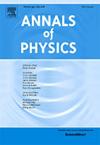Yang–Mills extension of the Loop Quantum Gravity-corrected Maxwell equations
IF 3
3区 物理与天体物理
Q2 PHYSICS, MULTIDISCIPLINARY
引用次数: 0
Abstract
In this paper, we endeavor to build up a non-Abelian formulation to describe the self-interactions of massless vector bosons in the context of Loop Quantum Gravity (LQG). To accomplish this task, we start off from the modified Maxwell equations with the inclusion of LQG corrections and its corresponding local gauge invariance. LQG effects in the electromagnetic interactions have significant importance, as they might be adopted to describe the flight time of cosmic photons coming from very high-energy explosions in the Universe, such as events of Gamma-Ray Bursts (GRBs). These photons have energy-dependent speeds, indicating that the velocity of light in the vacuum is not constant. To carry out the extension from the Abelian to the non-Abelian scenario, we shall follow the so-called Noether current procedure, which consists in recurrently introducing self-interactions into an initially free action for vector bosons by coupling the latter to the conserved currents of a global symmetry present in the action of departure. In the end of the non-Abelianization process, the initial global symmetry naturally becomes local. Once the Yang–Mills system includes LQG correction terms, it becomes possible to analyze how quantum-gravity induced contributions show up in both the electroweak and the QCD sectors of the Standard Model, providing a set-up for phenomenological investigations that may bring about new elements to discuss Physics beyond the Standard-Model.
求助全文
约1分钟内获得全文
求助全文
来源期刊

Annals of Physics
物理-物理:综合
CiteScore
5.30
自引率
3.30%
发文量
211
审稿时长
47 days
期刊介绍:
Annals of Physics presents original work in all areas of basic theoretic physics research. Ideas are developed and fully explored, and thorough treatment is given to first principles and ultimate applications. Annals of Physics emphasizes clarity and intelligibility in the articles it publishes, thus making them as accessible as possible. Readers familiar with recent developments in the field are provided with sufficient detail and background to follow the arguments and understand their significance.
The Editors of the journal cover all fields of theoretical physics. Articles published in the journal are typically longer than 20 pages.
 求助内容:
求助内容: 应助结果提醒方式:
应助结果提醒方式:


